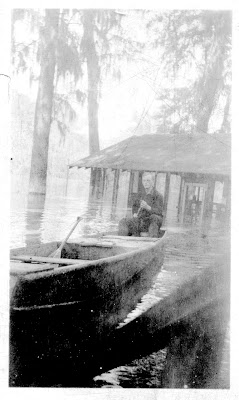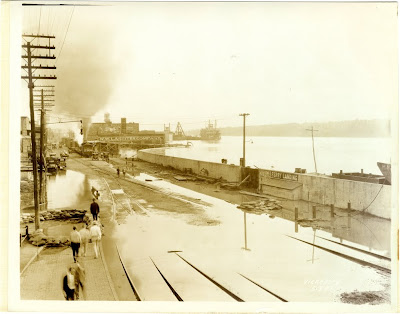With the approach of record-breaking floods on the Mississippi in May of 2011, this blog is a reprint an issue of the
Vicksburg Photopage newsletter from 1998, which gave some background to floods along the great waterway.
Introduction. “That Ol’ Man River, he just keeps rolling along...” (From Jerome Kern’s and Oscar Hammerstein’s 1927
Show Boat. The great American bass, Paul Robeson, recorded “Ol’ Man River” in 1928 and many times thereafter.)
Ol’ Man River, is, of course, the mighty Mississippi, the father of waters. This grand waterway has always inspired awe and respect, and never more so than when it is in flood. When snow melt or unusual rainfall causes greater than normal inflow in a short time span, the waters rise, overtop the natural levees or banks, and spread out across the river valley. The greatest flood of record was in 1927, when 500 people were killed and half a million driven from their homes in the lower Mississippi Valley. The Mississippi Delta was particularly hard hit. In response to the tremendous economic damage and loss of life, Congress passed the Flood Control Act of 1928, directing the U.S. Army Corps of Engineers to embark on the ambitious project of taming the great river by building levees that would maintain it in its banks, even during floods. For the most part, the Corps has been remarkably successful. However, part of the project remains incomplete, and occasionally, the rivers rise so high that the existing levees are unable to contain the immense flow of water.
Geologic note. “The Delta” refers to the flat, fertile river plain north of Vicksburg and south of Memphis, a fertile agricultural area. Historically, the Mississippi periodically flooded the flat river plain and deposited rich soil. The geologic delta of the Mississippi River is an immense accumulation of un-consolidated sediment that protrudes south into the Gulf of Mexico. Normally, when folks say “the Delta,” they are referring to the farming area in northern Mississippi.
Definitions. Originally, the term
flood meant an overflowing of water over land that was usually dry. Now that the river is channelized, flood is defined as a water level above a set elevation. Because a river flows downhill, the flood elevation varies at different points along its course. For example, flood elevation at Memphis is different than flood in Vicksburg, and gage zero (the elevation where the measuring staff is defined as zero) is different as well. The US Army Corps of Engineers and the US Geological Survey record water levels at hundreds of stations throughout the nation.
Vicksburg gage 15145. This gage is located about 0.3 miles south of the I-20 bridge. Zero on the gage is 46.23 feet above the National Geodetic Vertical Datum (which is approximately sea level). Bank full, or flood stage, is 43.0 feet above gage zero. During some droughts, the water elevation drops below gage zero, but this does not mean that there is no water flow.

The graph above shows river elevations for 1973 (major flood), 1988 (drought) and 1997 (flood). During the 1988 drought, the water level was so low, long-lost sunken barges and steamboats emerged.
-->
Table 1.
Mississippi River Elevations at Vicksburg
|
Event
|
Date
|
Elev.
|
Bank full
|
|
43.0
|
Record flood crest (estimated because levees failed)
|
1927
|
56.0
|
Record measured crest
|
Feb 21, 1937
|
53.24
|
Record low stage
|
Feb 3, 1940
|
-7.0
|
1973 flood crest
|
May 13, 1973
|
53.1
|
1993 high
|
May 18, 1993
|
43.6
|
1994 high
|
May 3, 1994
|
46.0
|
1995 high
|
June 12-13, 1995
|
47.0
|
1996 high
|
June 1-3, 1996
|
43.6
|
1997 flood crest
|
Mar 22-26, 1997
|
49.1
|
1998 high
|
May 14, 1998
|
43.5
|
Source: U.S. Army Corps of Engineers, Vicksburg District. Elevations in feet above gage zero.
|
In Table 1, you can see that the record low water was 7 feet below zero, while the crest of the 1927 flood was estimated to be 56.0 feet. This means the water level can vary as much as 63 feet, making it difficult to design wharfs and landings. In Vicksburg, the spring crest is typically at or above flood stage, but only when it is predicted to rise above 45 feet do the city workers prepare to close the flood gates.
The Flood of 1927. This was greatest natural disaster of the 20th century in this part of the world, destroying homes, inundating hundreds of square miles, displacing thousands, killing cattle and livestock, and bringing about vast social changes. Disaster relief was slow and haphazard. Blacks and rural poor whites were treated shabbily by the wealthy establishment. Barry (1997) speculates that populists like Huey Long in Louisiana gained political power as a direct result of the discontent that millions felt and their conviction that something in the social order needed to change.
Reference: Barry, John M. 1997.
Rising Tide: the Great Mississippi Flood of 1927 and How it Changed America, Simon & Schuster, New York.
The following 1927 photographs were kindly loaned to me by a former coworker and life-long Vicksburg resident. They were taken by her father, Mr. Emil Menger. Mr. Menger and his brothers regularly walked about four miles from Clay Street to Long Lake to fish.

Mr. Emil Menger at Long Lake (northwest of Vicksburg in the flood plain of the Yazoo River).

Mr. Menger’s boat at Long Lake, Mississippi, during the 1927 flood. The gun is still in the family’s collection.

Flooded road in Vicksburg, probably Hwy 61 North (North Washington Street).
From New Orleans District Corps of Engineers: "The Mississippi River has the third largest drainage basin in the world, exceeded in size only by the watersheds of the Amazon and Congo Rivers. It drains 41 percent of the 48 contiguous states of the United States. The basin covers more than 1,245,000 square miles, includes all or parts of 31 states and two Canadian provinces, and roughly resembles a funnel which has its spout at the Gulf of Mexico. Waters from as far east as New York and as far west as Montana contribute to flows in the lower river."

Mississippi River drainage area with Mississippi River & Tributaries Project area (in pink). From New Orleans District

This map shows the areas flooded in 1927. The map was prepared by the Commission headed by Herbert Hoover. Image courtesy NOAA Central Library and Mr. John Cloud.
The Mississippi Department of Archives and History has a fascinating collection of 1927 photographs on their web page. Highly recommended!
http://mdah.state.ms.us/arrec/digital_archives/1927flood/
For more information on the 2011 flood, please see some of my
later blog articles.










